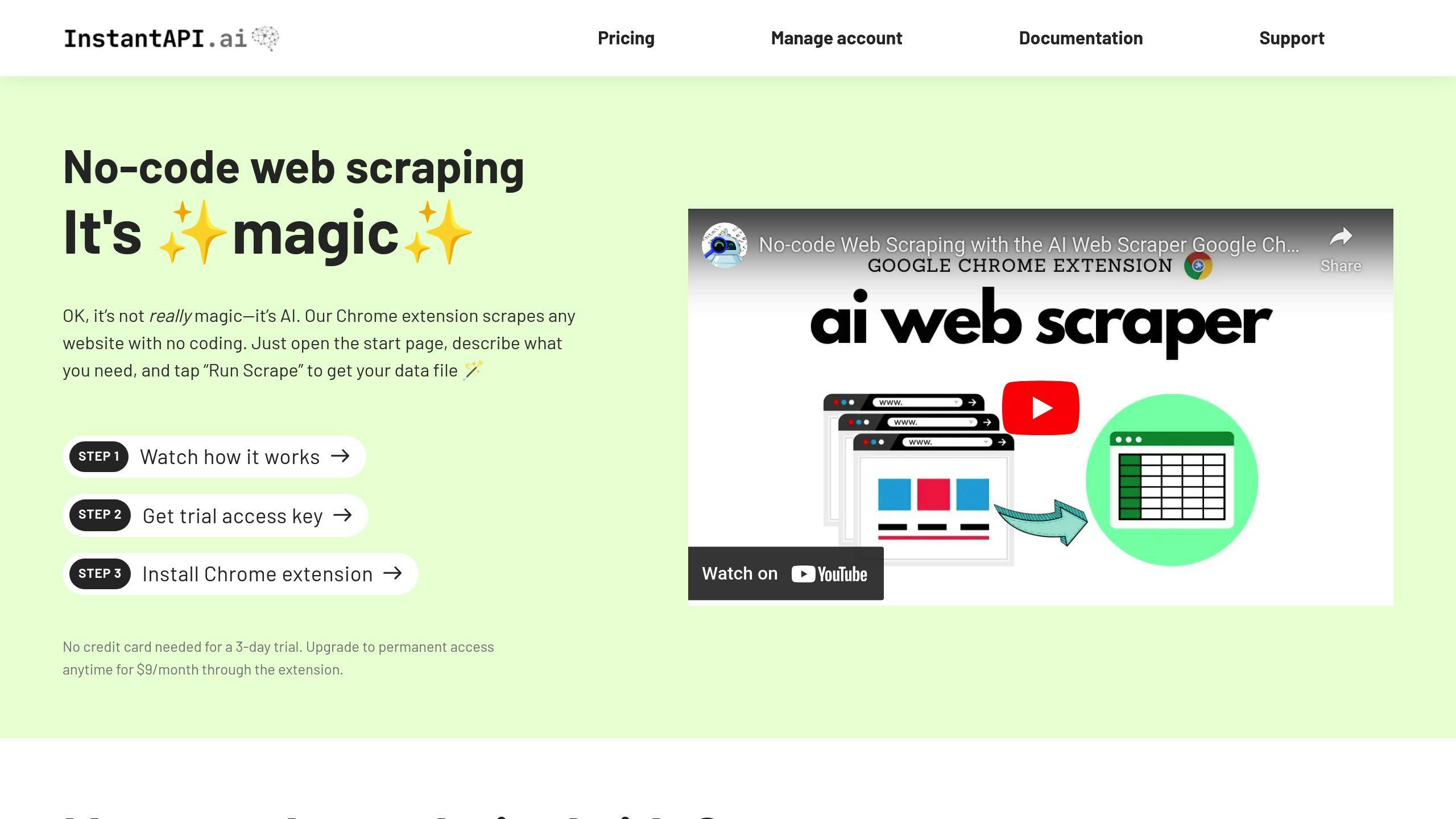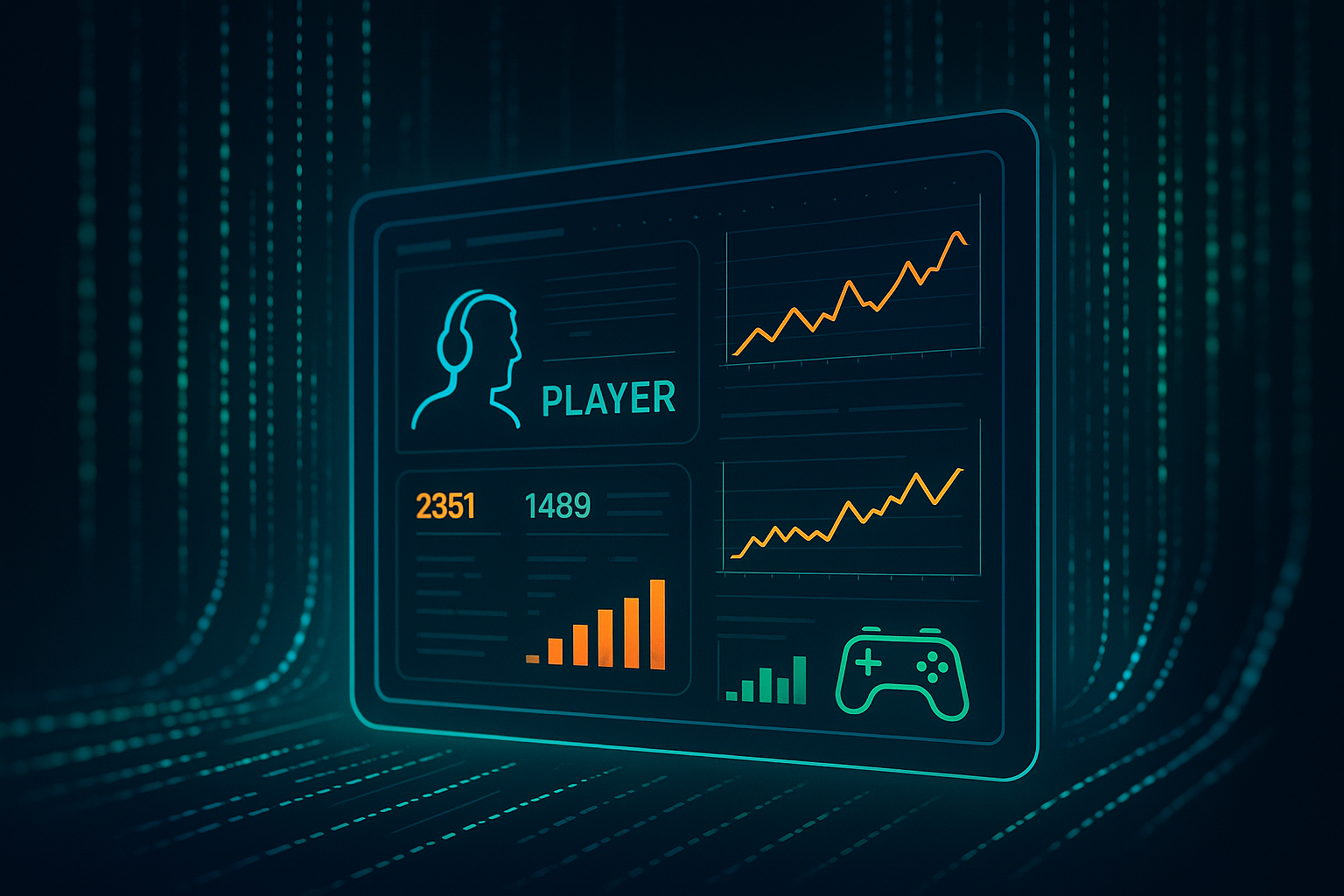AI has transformed data filtering by automating processes, improving accuracy, and spotting patterns that humans or traditional methods often miss. Here's a quick breakdown of its impact:
- Speed: Processes data in minutes instead of hours or days.
- Accuracy: Achieves over 90% precision compared to 60-70% with older methods.
- Scalability: Handles large datasets without manual effort.
- Pattern Recognition: Learns complex patterns beyond simple rules.
- Automation: Reduces repetitive tasks and adapts to changing data.
Key Tools and Methods
- Machine Learning: Decision trees, random forests, and neural networks for pattern detection.
- NLP: Tokenization, sentiment analysis, and entity recognition for text-based data.
- Automation: Tools like InstantAPI.ai and Powerdrill AI simplify data filtering.
Quick Comparison of AI Tools
| Tool | Best For | Pricing | Expertise Needed |
|---|---|---|---|
| InstantAPI.ai | Web scraping & filtering | From $9/month | Minimal |
| Powerdrill AI | Text data processing | Use-case based | Moderate |
| ML Libraries | Custom filtering algorithms | Often open-source | Advanced |
Why It Matters
AI reduces costs, enhances decision-making, and improves efficiency in industries like healthcare and finance. For example, fraud detection accuracy has improved by 25%, and false positives in medical assessments have dropped by 60%.
By starting small and addressing data quality, AI tools can help you achieve smarter, faster, and more reliable data filtering.
Related video from YouTube
Key Concepts and Methods for AI Data Filtering
Machine Learning Methods for Data Filtering
AI-driven data filtering leans on powerful machine learning algorithms to uncover patterns in complex datasets. Three key methods stand out: decision trees, random forests, and neural networks.
- Decision trees simplify data by breaking it into logical paths based on specific rules.
- Random forests take this a step further, combining several decision trees to handle more intricate scenarios and minimize errors.
- Neural networks excel at identifying deeper, non-linear relationships within data.
A great example is Qdrant's vector search, which uses machine learning to uncover connections that traditional methods might overlook. These approaches are essential for turning vast amounts of data into actionable insights.
Using Natural Language Processing (NLP) for Data Filtering
NLP revolutionizes text-based data filtering by breaking language into manageable components. It works through processes like tokenization, sentiment analysis, and named entity recognition, each serving distinct purposes:
| NLP Component | Function | Application |
|---|---|---|
| Tokenization | Splits text into words or phrases | Highlights key terms in documents |
| Sentiment Analysis | Evaluates emotional tone | Filters customer feedback by tone |
| Named Entity Recognition | Identifies specific types of information | Extracts names, dates, or locations |
Powerdrill AI uses these capabilities to streamline text data processing. By categorizing and filtering unstructured text while keeping its context intact, their system is a game-changer for organizations handling large text datasets.
Automating Data Filtering with AI
InstantAPI.ai showcases the power of automation, processing thousands of data points every second with impressive accuracy. To make automated filtering work effectively, certain steps are key:
- Feature Selection: Pinpointing the most relevant attributes in the data.
- Model Training: Teaching the AI using high-quality datasets.
- Validation Protocols: Running checks to ensure the filtering process is accurate.
These systems are already delivering results. For example, AI-powered chatbots can now filter and direct customer inquiries with over 90% accuracy, cutting response times and enhancing service quality.
Looking ahead, advancements in deep learning models promise even greater precision. With these methods as a foundation, we can dive into specific tools that bring AI-driven filtering to life.
AI Tools and Solutions for Data Filtering
Overview of InstantAPI.ai

InstantAPI.ai brings together AI-driven web scraping and an easy-to-use interface, making data filtering accessible for users regardless of their coding skills. Created by Anthony Ziebell, the platform offers a no-code Chrome extension for straightforward web scraping. Users can perform unlimited scrapes for just $9/month through its automated setup.
The enterprise API solution includes features like:
- Premium proxy access and tools for handling dynamic websites
- Automatic updates to maintain filtering precision
- Dedicated support for seamless implementation
While InstantAPI.ai focuses on simplicity and accessibility, other tools provide specialized features that may better suit certain needs.
Comparison of AI Data Filtering Tools
Choosing the right AI tool depends on your specific requirements. Here's a quick breakdown of some leading options:
| Feature | InstantAPI.ai | Powerdrill AI | Traditional ML Libraries |
|---|---|---|---|
| Interface | No-code Chrome extension + API | Automated filtering platform | Code-based implementation |
| Best For | Web data extraction & filtering | Text data processing & analysis | Custom filtering algorithms |
| Pricing Model | From $9/month (Extension) | Varies by use case | Often open-source |
| Technical Expertise | Minimal | Moderate | Advanced |
| Integration Options | API, Chrome extension | API | Programming libraries |
This table shows how each tool is tailored to different use cases. For example, InstantAPI.ai is ideal for web-based tasks, Powerdrill AI focuses on text processing, and traditional machine learning libraries offer flexibility for building custom solutions.
For more advanced filtering pipelines, combining tools might be necessary. InstantAPI.ai shines in web scraping, Powerdrill AI handles automated text filtering, and machine learning libraries provide the tools for creating entirely custom workflows. Each option brings something unique to the table, giving industries the flexibility to meet their specific challenges.
sbb-itb-f2fbbd7
Steps to Use AI for Data Filtering
Step-by-Step Guide to Implementing AI
Using AI for data filtering requires a clear and organized approach. Here's how organizations can successfully integrate AI into their processes:
1. Define Clear Objectives
Start by setting specific goals and success metrics. For instance, a healthcare provider might aim to cut false positives in patient risk assessments by 40% while keeping 95% accuracy in identifying high-risk cases.
2. Assess Infrastructure and Data Quality
Review your current data setup and prepare it for AI integration. Key actions include:
- Performing regular data audits and automated cleaning
- Standardizing formats and ensuring input validation
- Implementing centralized data systems
- Establishing data governance policies and metadata tagging
- Monitoring data quality consistently
3. Select the Right Tools
Choose AI tools that match your needs and capabilities. Consider the following:
| Factor | Consideration |
|---|---|
| Data Volume | Capacity needed for processing |
| Integration Needs | Compatibility with current systems |
| Technical Expertise | Skills available in-house |
| Budget | Overall cost of ownership |
| Security Needs | Compliance with industry standards |
4. Deploy and Monitor
Once you've selected the tools, focus on implementation and ongoing improvements. For example, a financial institution used anomaly detection algorithms in an AI-driven transaction filtering system, cutting fraudulent transactions by 67% in three months while processing over a million transactions daily.
Tips for Effective AI Data Filtering
Performance Optimization
Regular bias audits and diverse datasets help improve filtering fairness. For example, Zebra Medical Vision achieved 92% accuracy in analyzing medical images by continuously refining its models.
Cross-functional Collaboration
Bring technical and domain experts together to:
- Build context-aware models
- Provide support during implementation
- Collect and act on user feedback
Continuous Learning
Use feedback systems to enhance accuracy. A social media platform boosted filtering precision by 45% through automated alerts and frequent algorithm reviews.
Security and Compliance
Ensure your AI system adheres to:
- Data privacy regulations
- GDPR and other industry-specific rules
- Transparent decision-making processes
- Regular security audits
Future Developments and Ethical Issues
New AI Technologies in Data Filtering
AI-driven data filtering is advancing quickly, reshaping how we analyze and process information. Cutting-edge Natural Language Processing (NLP) models now go far beyond simple text analysis, offering deeper insights and context.
Quantum computing is another game-changer, capable of handling highly complex filtering tasks at speeds traditional systems can't match. Meanwhile, federated learning is changing the way AI models are trained. By allowing institutions to collaborate without sharing sensitive data, it's especially useful in fields like healthcare, where privacy is crucial.
| Technology | Expected Impact by 2025 |
|---|---|
| Advanced NLP | Improved contextual understanding, 40% accuracy boost |
| Quantum Computing | Processing speeds up to 100 times faster |
| Federated Learning | 70% reduction in data exposure |
| Edge Computing | 90% faster response times |
As these technologies evolve, they bring not only opportunities but also challenges, particularly in ethics and data privacy.
Ethics and Privacy in AI Data Filtering
The rise of AI in data filtering comes with critical ethical questions. Transparency is a major concern - 41% of organizations report challenges in making AI decisions clear, according to the IBM Global AI Adoption Index 2022. This highlights the urgent need for better oversight and accountability.
"The future of AI in data filtering lies not just in its efficiency, but in its ability to be transparent, ethical, and aligned with human values." - Dr. Fei-Fei Li, Professor of Computer Science at Stanford University, AI Ethics Conference 2024
To tackle these issues, organizations are focusing on several key areas:
1. Bias Detection and Mitigation
Frequent audits of AI systems are essential for spotting and fixing biases in filtering algorithms. Ensuring diverse and representative training data can help prevent discriminatory outcomes.
2. Privacy-Preserving Technologies
Tools like homomorphic encryption allow data to be analyzed while still encrypted, protecting sensitive information. This approach ensures AI systems remain effective while adhering to privacy laws.
3. Regulatory Compliance
With the EU AI Act set to take effect in 2025, organizations must prepare to meet strict regulations. Key steps include:
- Using explainable AI (XAI) to make decisions more understandable
- Keeping detailed audit trails of AI processes
- Building strong data governance frameworks
- Establishing clear and transparent reporting practices
"As AI becomes more prevalent in data filtering, we must prioritize the development of robust governance frameworks to ensure these systems are used responsibly and ethically." - Margrethe Vestager, Executive Vice President of the European Commission for A Europe Fit for the Digital Age, World Economic Forum 2024
Emerging technologies like blockchain can also enhance transparency by creating unchangeable audit trails. As these tools develop, they promise faster, more secure data filtering while maintaining high ethical standards.
Final Thoughts on AI in Data Filtering
Highlights of AI's Impact on Data Filtering
AI-powered data filtering has changed the game for data management. It cuts processing time by 70% and boosts accuracy by 40%, making it a go-to solution for industries like finance and healthcare. For example, these sectors have seen a 60% decrease in false positives and a 25% improvement in fraud detection rates. Here's a quick breakdown of the results:
| Impact Area | Improvement Achieved |
|---|---|
| Processing Speed | 70% faster data analysis |
| Accuracy | 40% increase in precision |
| Cost Savings | $2M average annual reduction |
| Decision Making | 35% faster insights |
These stats show just how impactful AI tools can be for businesses looking to streamline operations and make smarter decisions.
Why You Should Consider AI Tools
AI filtering tools are easier to use than ever. You don’t need to overhaul everything at once - start small by tackling one specific problem. Choose tools that come with strong support to ensure a smooth implementation. Dr. Andrew Ng puts it best:
"AI-driven data filtering is not just about efficiency; it's about uncovering insights that were previously hidden in the noise of big data."
And the numbers back it up: a McKinsey study found companies using AI experienced 23% higher revenue growth. By integrating these tools responsibly and addressing concerns like privacy and transparency, organizations can fully leverage AI's potential while staying ethical.
As AI continues to improve, responsible adoption will open the door to even more opportunities for smarter, faster, and more insightful data management.


